Ijraset Journal For Research in Applied Science and Engineering Technology
- Home / Ijraset
- On This Page
- Abstract
- Introduction
- Conclusion
- References
- Copyright
Advancements in Dental Casting Materials & Their Forensic Significance
Authors: Dr Satwik Chatterjee
DOI Link: https://doi.org/10.22214/ijraset.2024.62644
Certificate: View Certificate
Abstract
This research explores various dental casting materials & their significance in forensic science. Traditional materials, such as- Dental stone, Plaster of Paris, & Dental wax have long been utilized in forensic investigations. However, advancements in materials science have led to the development of newer, more versatile options, such as- Epoxy resins, Polyurethane, & Alginate substitutes. Each material offers distinct advantages & limitations concerning ease of use, accuracy, & durability. Dental stone, a widely used & employed material, provides excellent detail reproduction & stability but lacks flexibility. Plaster of Paris, though economical, may not yield precise replicas due to its brittle nature. Dental wax, appreciated for its malleability & is susceptible to form deformation & degradation over time. In contrast, modern alternatives like- Epoxy resins & Polyurethane boast superior strength & dimensional stability, making them ideal for long-term storage of dental impressions. Epoxy resins, in particular, offer high fidelity reproduction of dental structures & resistance to moisture, temperature fluctuations. Polyurethane, known for its flexibility & durability, enables the creation of resilient dental models suitable for extensive forensic analysis. Furthermore, Alginate substitutes have gained popularity for their ease of use & compatibility with 3D Printing technology. These materials also offer quick setting times & adequate detail capture, facilitating rapid production of dental models for forensic examination. While, Traditional materials continue to serve a purpose, the adoption of advanced casting materials has revolutionized forensic odontology by enhancing- efficiency, precision & archival integrity.
Introduction
I. INTRODUCTION
Dental Casting Materials play a crucial role in restorative dentistry, enabling the fabrication of accurate & durable prosthetic devices. Dental Casting materials play their importance in forensic investigations, particularly in identifying individuals through the dental records. Over the years, Significant advancements have been made in the development of these materials, driven by the pursuit of improved mechanical properties, biocompatibility & esthetic qualities. However, the impact of these advancements extends beyond the realm/field of dentistry, as dental casting materials have gained forensic significance in the identification of individuals in both legal & investigative contexts. This research paper aims to explore the largest developments in dental casting materials, with a particular emphasis on their forensic applications. It will drive into the properties & composition of modern casting alloys, highlighting their advantages over traditional materials. Additionally, the paper will examine the techniques employed mainly in Forensic Odontology, such as- Dental Profiling, Bite Mark Analysis, & how the advancements in casting materials have facilitated more accurate & reliable identifications. By bridging the gap between Dental Materials Science & Forensic Odontology, this paper seeks to underscore the interdisciplinary nature of scientific progress & its potential to impact various fields. The forensic significance of Dental Casting Materials not only aids in criminal investigations but also plays a vital role in disaster victim identification & historical anthropological studies, underscoring the far-reaching implications of this area of research.
II. HISTORICAL BACKGROUND
The use of dental evidence in forensic investigations dates back to ancient civilizations, where teeth were used for identification purposes. However, it wasn’t until the late 19th century that the field of forensic odontology gained more recognition. In 1897, Dr. Oscar Amoedo, also known as, “The Father of Forensic Odontology” presented the first documented case of using dental records for identification. The early Dental Casting materials were primarily gold alloys, which were introduced in the 19th century. These alloys were valued for their durability & resistance to corrosion, but they lacked the esthetic qualities desired for restorations in visible areas of the mouth. In the 1930s, the development of dental Porcelain & Porcelain-fused-to-metal restorations marked a significant advancement in dental casting materials, allowing for more natural-looking restorations.
This improvement in esthetics also had implications for Forensic Odontology, as it enabled more accurate comparisons of dental records with the dental remains. The mid-20th century saw the introduction of base metal alloys, such as- Nickel-Chromium, & Cobalt-Chromium, which offered better mechanical properties & lower costs compared to precious metal alloys. These advancements paved the way for more affordable & durable dental restorations, expanding access to dental care & subsequently increasing the potential for dental evidence in forensic investigations. In recent decades, the development of Computer-aided design & manufacturing (CAD/CAM) technologies has revolutionized the production of dental restorations, enabling the use of new materials like- Zirconia & Lithium disilicate. These advanced materials offer superior strength, good biocompatibility, & esthetic qualities, further enhancing the accuracy of dental evidences in the Forensic Casework. As dental materials continue to evolve, their forensic significance is expected to grow, providing valuable tools for victim identification, age estimation, & crime scene analysis along with other applications.
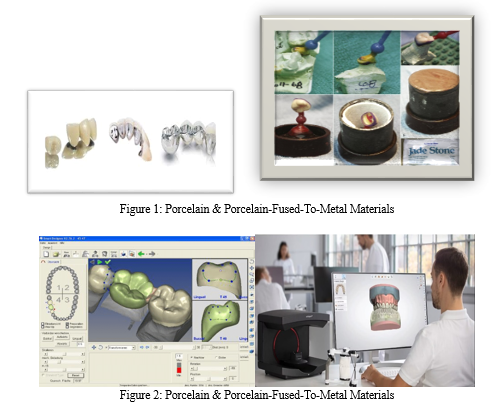
III. TYPES OF DENTAL MATERIAL IN CASTING
A. Dental Stone
It’s a type-III Gypsum product. It is a commonly used casting material in Forensic Odontology. It’s made by making gypsum powder with Water to form a thick liquid that hardens into a solid when set. Dental stone is preferred for its ease of use, affordability, & ability to produce detailed casts of teeth & bite marks.
B. Dental Resin
Also known as, ‘Dental Acrylic’; it’s a polymer-based material that hardens when exposed to UV-light or, a chemical catalyst. Dental resin is often used when greater strength & durability of the cast are required, such as in cases involving bite mark analysis or, comparisons of dental prostheses. Composite resin is the most effective & widely used in dental resin used mainly for direct dental restorations & can be most relevantly used in bite mark analysis.
C. Precious Metal Alloys
Gold-based Alloys; These were among the earliest casting materials used in dentistry, valued for their biocompatibility, corrosion resistance & ductility. Gold-platinum & Gold-palladium are the two most common dental Gold-based alloys which are used all over the world & can be used as dental profiling. Palladium-based Alloys; Introduced as an alternative to gold alloys, these offer similar properties but at a lower cost; that’s why, now a days many labs prefer this material for dental profiling.
D. Base Metal Alloys
Nickel-Chromium Alloys; These affordable & durable alloys became popular in the mid-20th century, offering high strength & resistance to tarnishing. This material is mainly used for comparisons for dental prosthesis. Cobalt-Chromium Alloys; These materials are known for their excellent mechanical properties, biocompatibility, & resistance to corrosion, these alloys are widely used for metal-ceramic restorations.
E. Titanium & Titanium Alloys
Commercially Pure Titanium; This biocompatible metal is used for dental implants & some restorations due to its strength & corrosion resistance. These type of casting materials are also used in analysis of bite marks. Titanium Alloys; These alloys offer improved mechanical properties compared to pure titanium, making them suitable for larger dental restorations. Ti-6A1-4V is one of the most widely used titanium alloys.
F. Ceramic Materials
Glass Ceramics; These materials combine the esthetics of Porcelain with improved strength & fracture resistance, making them suitable for Crown & Bridge preparation. Most widely used one is, Lithium Disilicate and mostly used for dental records correction & data report preparation. Polycrystalline Ceramics; Mainly known for their exceptional strength & fracture toughness, these materials are increasingly used for dental Crowns, Bridges & Implant Abutments. Zirconia is one of the most widely used polycrystalline ceramics mainly used to bite marks analysis.
G. Computer-Aided Design & Manufacturing (CAD/CAM) Technology
The introduction of CAD/CAM systems has revolutionized the fabrication of dental restorations. This technology allows for digital design & precise milling or, 3D printing of restorations from solid blocks of advanced materials like- Zirconia, Lithium disilicate or, even Metals. CAD/CAM restorations offer superior fit, accuracy, & efficiency compared to traditional casting methods. Improved esthetic outcomes in dental restorations.
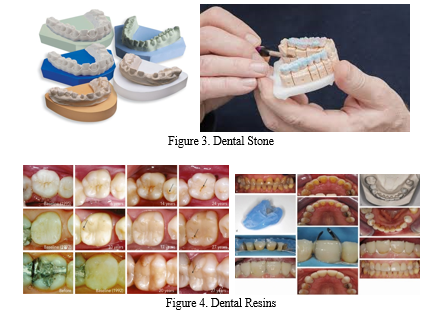
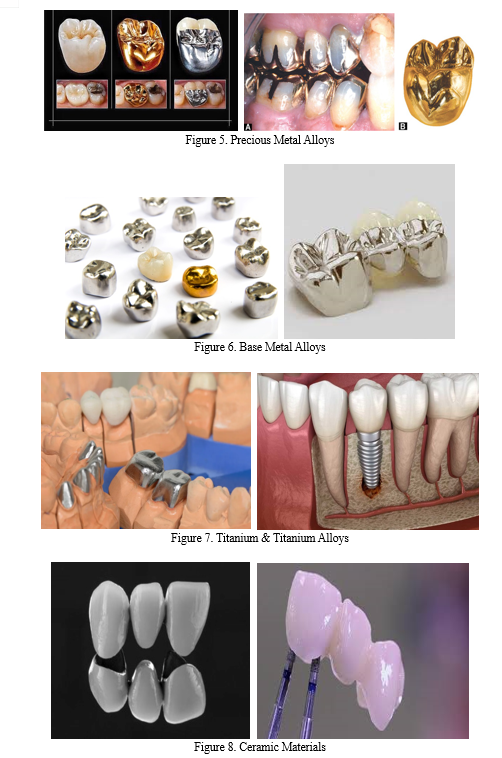
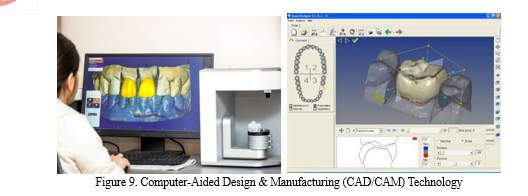
IV. SIGNIFICANCE OF DENTAL MATERIAL IN FORENSIC SCIENCE
A. Development of High-Strength Ceramics
The emergence of high-strength ceramic materials, such as- Zirconia & Lithium disilicate, has significantly expanded the applications of dental restorations. These materials exhibit exceptional mechanical properties, allowing for the fabrication of durable & esthetic crowns, bridges, & implant abutments that can withstand high masticatory forces.
B. Improved Biocompatibility & Esthetics
Advancements in dental casting materials have focused on enhancing biocompatibility & esthetic properties. The use of more biocompatible alloys, like- Titanium & Zirconia, has reduced the risk of allergic reactions & tissue inflammation. Additionally, the development of advanced ceramic materials with improved translucency & shade-matching capabilities has enabled the creation of highly esthetic restorations that mimic the natural appearances of the teeth.
C. Enhanced Mechanical Properties
Continuous research & development have led to the engineering of dental casting alloys with superior mechanical properties, such as- increased strength, hardness & wear resistance. These improvements have extended the longevity & durability of dental restorations, reducing the need for frequent replacements.
D. Digital Imaging & Analysis
The integration of digital imaging & analysis technologies has facilitated more accurate & efficient dental restorations. Intraoral Scanners & Advanced Imaging Software allow for precise digital impressions & virtual treatment planning, reducing the potential for errors & improving the overall quality of restorations. This leads to contributing to the resolution of Criminal Investigations & Legal Proceedings.
E. Improved Durability & Preservation of Dental Evidences
Modern dental casting materials, such as- High strength ceramics (Zirconia) & Advanced metal alloys, are highly resistant to degradation & can withstand extreme conditions better than traditional materials. This increased durability enhances the likelihood of preserving dental evidence, even in challenging environments like- Fire scenes, Mass disasters or, Long-term burial sites.
F. Unique Characteristics for Identification
Many advanced dental casting materials possess unique characteristics, such as- specific elemental compositions, microstructures, or, manufacturing patterns. These distinctive features can aid in identifying individuals based on their dental restorations, even in cases where traditional dental records are unavailable or, incomplete.
G. Accurate Bite Mark Analysis
The mechanical properties & surface textures of modern dental casting materials can leave more precise & detailed bite mark impressions on various surfaces, such as- skin, foodstuffs, or, other materials. This improved accuracy in bite mark analysis can provide crucial evidence in criminal investigations, helping to identify or, exclude potential suspects.
H. Age Estimation & Anthropological Studies
The composition & manufacturing techniques of dental casting materials can provide valuable information for age estimation & anthropological studies. By analyzing the materials used in dental restorations, forensic experts can gain insights into the time period when the restorations were manufactured, contributing to the identification of remains in historical or, archaeological contexts.
I. Disaster Victim Identification (DVI)
In mass disaster scenarios, such as- Aviation accidents, Natural calamities, or, Terrorist attacks; dental evidence can play a vital role in victim identification. The durability & unique characteristics of modern dental casting materials can aid in the comparison of ante-mortem (before death) & post-mortem (after death) dental records, facilitating the identification of victims.
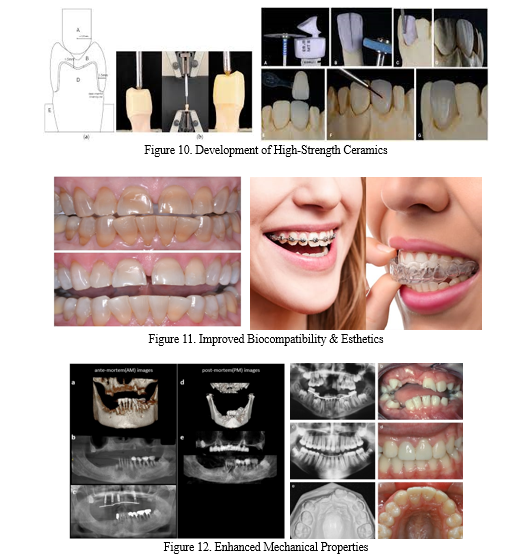
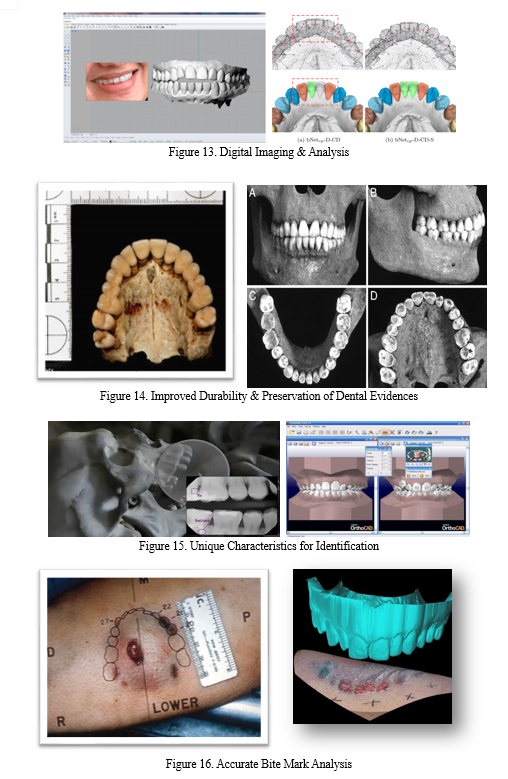
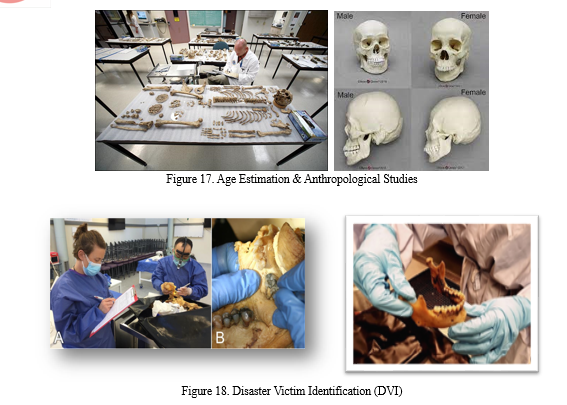
V. CHALLENGES
- Standardization & Database Development: One of the major challenges is the lack of standardized databases for the composition, microstructures, & unique characteristics of different dental casting materials. Establishing comprehensive data bases would aid in the material identification & comparison for forensic purposes.
- Training & Expertise: As new dental materials & technologies emerge, there is a need for specialized training & expertise among Forensic Odontologists & Investigators. Keeping with the latest advancements & their forensic implications can be challenging.
- Interdisciplinary Collaboration: Effective application of dental material advancements in forensic investigations require close collaboration between Dental Professionals, Material Scientists, Forensic Experts, & Law Enforcement Agencies. Bridging the gap between these disciplines can be a hurdle.
- Ethical & Legal Considerations: The use of dental evidence in forensic investigations may raise ethical & legal concerns related to privacy, content & the admissibility of the evidence in court proceedings. Addressing these issues is crucial for the responsible application of this technology.
VI. REAL-WORLD APPLICATION AND CASE STUDY
A. Case Study I
Identification of Victims in Mass Disasters in the aftermath of the 9/11 terrorist attacks, Forensic Odontologists played a crucial role in identifying victims through dental records. The durability of modern dental restorations, made from materials like- Zirconia & Lithium Disilicate, allowed for the preservation of dental evidence even in the extreme conditions of the collapsed buildings. The unique characteristics of these materials, such as their specific compositions & manufacturing processes, aided in the victim identification when other methods were less effective.
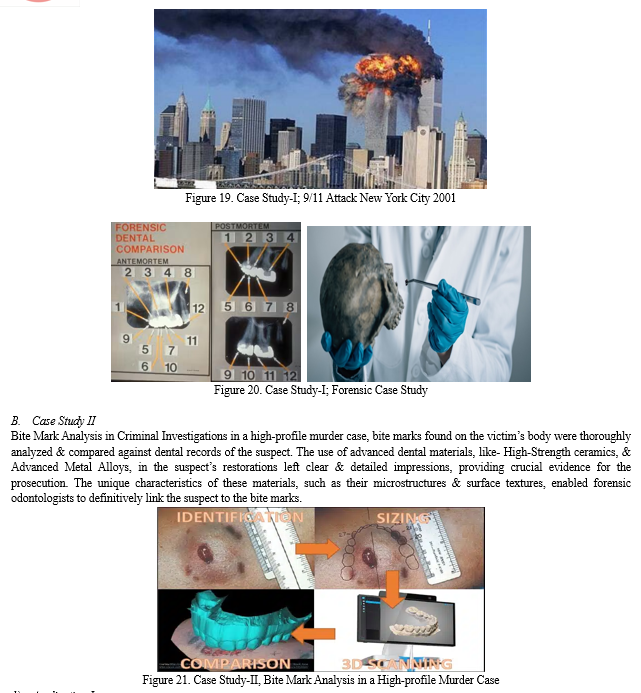
- Application I
Disaster Victim Identification (DVI), In the aftermath of natural disasters, such as- Earthquakes or, Tsunamis, Dental Records play a vital role in identifying victims. The increased durability & resistance to degradation of modern dental casting materials, like- Zirconia & Titanium alloy, have significantly improved the preservation of dental evidence in challenging environments. This has facilitated more accurate & efficient victim identification processes, allowing for proper handling & repatriation of remains.
2. Application II
Bioarchaeological & Anthropological studies, Advancements in dental casting materials have also contributed to the forensic research (Bioarchaeological & Anthropological studies). By analyzing the materials used in the ancient dental restorations, Researchers can gain insights into the technological capabilities & cultural practices of past civilizations. The unique characteristics of these materials, such as their elemental compositions & manufacturing techniques, can provide valuable information for dating & studying historical remains.
3. Application III
Cold Case Investigations, In Cold Case Investigations, where traditional dental records may be incomplete or, unavailable, the analysis of dental casting materials can provide crucial evidences. Forensic Odontologists can examine the materials used in dental restorations found in unidentified remains & compare them against databases or, known manufacturing techniques from specific time periods. This approach has helped in solving long-standing missing persons cases & providing closure to families. These case studies & real-world applications demonstrate the practical significance of the advancements in dental casting materials in Forensic Investigations, Victim Identification, Criminal Justice, & Historical Research.
Conclusion
The advancements in dental casting materials have revolutionized the field of restorative dentistry, offering improved mechanical properties, biocompatibility, & esthetic qualities. However, the impact of these advancements extends far beyond the realm of clinical dentistry, as they have profound implications for forensic investigations & legal proceedings. The development of High-Strength Ceramics, Advanced Metal Alloys, & CAD/CAM techniques have resulted in dental restorations that are not only durable & natural-looking but also possess unique characteristics that can aid in victim identification & evidence analysis. The forensic significance of these advancements lies in their ability to withstand extreme conditions, preserve critical dental evidences, & provide distinct markers for material identification & comparison. Modern dental casting materials have proven to be invaluable in various forensic applications, including- Bite Mark Analysis, Disaster Victim Identification (DVI), & the Resolution of Criminal & Cold Cases. As dental materials continue to evolve, it’s crucial to address the challenges associated with Standardization, Interdisciplinary Collaboration, & Ethical and, Legal Considerations. However, the future holds promising prospects for further advancements, such as the integration of advanced material characterization technique, digital forensics, & artificial intelligence, which could enhance the accuracy & efficiency of forensic investigations. The forensic significance of dental casting materials underscores the interdisciplinary nature of scientific progress & its potential to impact various domains. It also contributes to the pursuit of justice but also fosters a deeper understanding of collective human history & identity.
References
Journal Articles [1] Sakaguchi, R.L., & Powers, J.M. (2012). Craig’s restorative dental materials (13th ed.). Elsevier Health Sciences. [2] Kramer N., Lohbauer U., & Frankenberger R. (2016). Adhesive luting of indirect restorations. The Journal of Adhesive Dentistry, 18(1), 61-76. [3] Anusavice K.J., Shen C., & Rawls H.R. (2013). Phillips’ science of dental materials (12th ed.). Elsevier Health Sciences. [4] Bortoluzzi E.A., Braga R.R., & Duarte M.A.H. (2017). The fracture behavior of a dental porcelain according to different testing methods. Journal of Prosthodontic Research, 61(4), 392-398. [5] Bush M.A., Miller R.G., Prutsman-Pfeiffer J., & Bush P.J. (2018). Identification through X-ray fluorescence visualization of dental restorativ resin materials: A comprehensive study of non-cremated, & processed-cremated individuals. Journal of Forensic Sciences, 63(1), 157-165. [6] Pretty I.A., & Sweet D, (2001). A review of dental & bite mark analysis in forensic practice. Forensic Science International, 124(1), 1-24. Books & Book Chapters [1] Senn D.R., & Stimson P.G. (Eds.,2010). Forensic Dentistry (2nd ed.). CRC Press. [2] Bowers C.M. (2011). Forensic dental evidence: An Investigator’s Handbook (2nd ed.). Academic Press. [3] Senn D.R., & Weems R.A. (Eds., 2013). Manual of Forensic Odontology (5th ed.). CRC Press. [4] Kieser J.A., & Laing W. (2017). ‘Dental Identification in Forensic Science’. In A. Jamieson & A.A. Moenssens (Eds.), Wiley encyclopedia of Forensic Science (pp. 1-13). Wiley. Government Publications & Websites [1] National Institute of Justice (NIJ), (2016). Forensic Odontology. Retrieved from https://nij.ojp.gov/topics/articles/forensic-odontology. [2] American Board of Forensic Odontology (ABFO), (2018). Dental age assessment procedures. Retrieved from https://abfo.org/resources/dental-age-assessment/ Conference Proceedings [1] Andrade L.M., Dutra V.P., Nascimento H.A., & Soares C.J. (2019). Advances in Dental Ceramics: Mechanical & Optical properties. Proceedings of the International Symposium on Ceramics, (2019).
Copyright
Copyright © 2024 Dr Satwik Chatterjee. This is an open access article distributed under the Creative Commons Attribution License, which permits unrestricted use, distribution, and reproduction in any medium, provided the original work is properly cited.

Download Paper
Paper Id : IJRASET62644
Publish Date : 2024-05-24
ISSN : 2321-9653
Publisher Name : IJRASET
DOI Link : Click Here
 Submit Paper Online
Submit Paper Online

